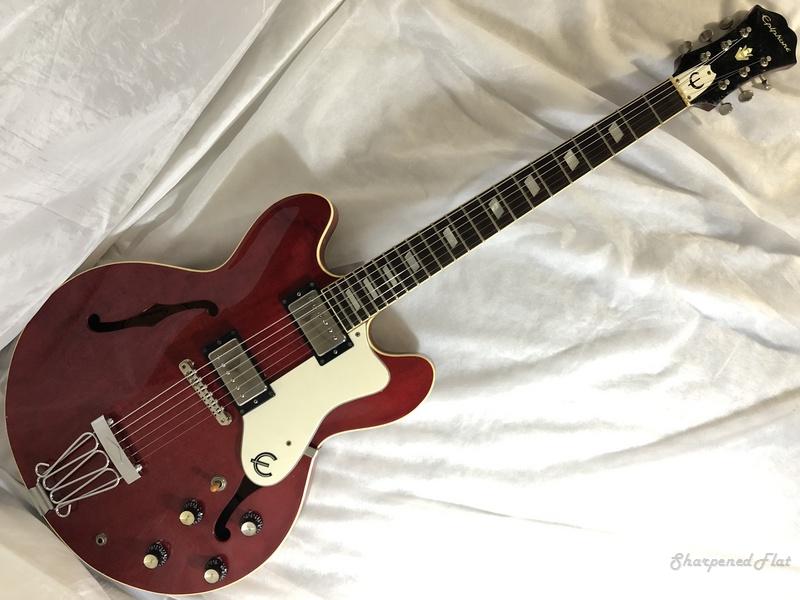- For information on dating a serial number, please see our Serial Number Guide. Identifying a particular model/variation can be difficult; please send the following information to service@gibson.com to assist us in identifying and/or dating your instrument quickly and accurately.
- Have model numbers that do not correspond with Kalamazoo made Epiphone model numbers listed below. Also the serial number is usually 7 digits or longer (unlike U.S. Made Epi's with a 6 digit or less serial number). Contact the vintage guitar info guy.
- In this video I have an epiphone black beauty les Paul custom 3 with no serial number on it. After doing some research I found that sticker serial numbers we.
- Epiphone Masterbuilt Banjo Serial Numbers From 1943 to 1947, the logo was a thick golden script, known as the banner logo. Some models (LG-2, J-45, SJ, select L-50s) included an actual banner reading 'Only a Gibson Is Good Enough' in the middle of the headstock.

ACOUSTIC GUITARS
Re: Epiphone Serial Number Decoder My epi is a 2000 Un-sung whoever that is. I could really care less cuz it's a killer axe, epi or not. In fact, I think mine is factory 2nd, it's got 2nd imprinted above the serial # on the back of the headstock.
Epiphone used a serialnumber system for their acoustic guitars. Two or three digits were ink stamped on the neck block or blind stamped on the interior back of the Recording models, three digits (or four ?) blind stamped on the interior back of the Seville models.
Recording E s/n 94 ink stamped on the neck block
Recording C s/n 275 blind stamped on the interior back below the soundhole
NOTE: Fisch & Fred mention a four-digit Seville 4 Special (called Model 4 Special s/n 5417) on page 235 .
The Masterbilt serialnumber system did not start with the number 1000 but with the number 5000. The reason for this is unknown. The serial numbers were blind stamped on the interior back under the bass f-hole, generally below but sometimes on the (oval) label, maybe even without a label like the earlier Recording and Seville models.
Broadway s/n 5053 blind stamped without a label
De Luxe s/n 5369 blind stamped below the label
De Luxe s/n 6677 blind stamped on the label
From about 1934 forward, the serial numbers were ink typed directly on the label (Long Island label) or letter pressed on the label (rectangular Masterbilt label, Green label and Blue label). see pictures

Quite often the serialnumber was also blind stamped (some handwritten) on the underside of the bridgefoot. Occasionally the serialnumber was handwritten on one of the braces.
Zenith s/n 7738
Olympic s/n 6851
Olympic s/n 11690
Epiphone Serial Numbers Dating
The s/n is sometimes ink typed on a label where it should have been letter pressed. According to Wiedler Epiphone often applied a newer type label with the old s/n typed in when a guitar was brought in for repair. There are also a few cases of a s/n on an older than typical label, probably either by mistake or because they had ran out of the current type see pictures For a reason unknown a new numbering system was applied in 1944 which started with number 50.000.
NOTE: Although the Sorrentino and the Howard guitars were offered under another brand, they are part of the same serial number system.
References :
Felix Wiedler, NY Epi Reg
Jim Fisch & L.B. Fred, The House of Stathopoulo, 1996, pp. 221-225
ELECTRIC GUITARS

“While Epiphone’s SN systems for acoustic instruments and 1950s electric hollow bodies appear to be pretty straightforward, the SN systems of their other electric instruments and amps are much less so. Over the years a number of different SN systems were used.” (Wiedler)

“With the inception of the Electar line in late 1935, Epiphone began a new numbering system which was employed solely on the electric instruments (Electar, Century, Coronet, Zephyr, Kent, Harry Volpe model). This manifested itself in the form of a blind stamped number between three and five digits, usually located on the top rear of the headstock. (Fisch & Fred, The House of Stathopoulo, page 225)
Wiedler wrote us June 2013: “The Electar series started at a lower s/n than 3-digit. The earliest example I have documented is s/n 25.
Until circa 1938 the s/n stamp is located on the top edge of the headstock. When the headstock shape of the Spanish electrics changed to the center-dip style the stamp was moved to the back of the headstock.
Wiedler wrote us May 2016: “The first Electar instruments from 1935 don’t show a serial number. In c. 1936 serial numbers started possibly near SN 1 (first documented is SN 25) and reached the 7000s by the time electric instrument/amp production was virtually halted during WW2. Currently I have listed Zephyr Spanish SN 7182 as the last pre-war electric guitar.
Epiphone Serial Numbersu97111250
When Epiphone restarted electric instrument production in 1946, only the Zephyr Hawaiian model carried on with the old SN system – the first documented is SN 7307. All other electric models used a new 5-6 digit SN system – with model-specific 2-3 digit prefix followed by a 3-digit serial suffix. This lasted until 1949. Around 1950 hollowbody electrics adopted the label/SN system of acoustic instruments (first documented example: Zephyr Regent SN 60182), while electric Hawaiian instruments used a new SN system starting around SN 9000.” see pictures
Epiphone Serial Numbers Japanese Made
References :
Felix Wiedler, NY Epi Reg
Jim Fisch & L.B. Fred, The House of Stathopoulo, 1996, p. 224-227
For Epiphone serialnumbers of the Upright Bass, see : Bass Monkey